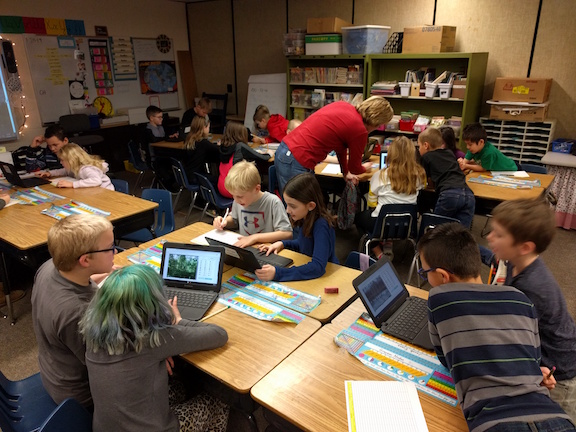Education
Resources for students and teachers
Minnesota Master Naturalist volunteer Amanda Drews and staff at Cedar Creek have created a whole pile of classroom resources that use Eyes on the Wild to teach some of the concepts in the elementary grade level Minnesota science standards! You can download the activities here. They include activities focused on living/non-living, animal weights, journaling and more!
For older students, postdoctoral researcher Dr. Meredith Palmer has built an interactive R Shiny app that allows for basic data exploration and visualization, hypothesis testing, and pairwise comparisons. Check it out here! We hope to add additional data-rich tools like this in the future.
Bingo cards! Fun for everyone!
Games and competitions are a great way to get folks of all ages engaged! As part of an expansion into passive programming for our local library system, we made Eyes on the Wild bingo cards. A Minnesota Master Naturalist, Amanda Drews, translated these bingo cards into a variety of languages spoken in Minnesota. Feel free to try these cards out with your kids, students, friends, or on your own! They help give direction to your classifications as well as cause to celebrate when you find things like researchers, vegetation or vehicles. We don't have prizes available through Cedar Creek, but we think it would be great to acknowledge bingos with candy, stickers or other small rewards.
Eyes on the Wild - in the classroom
Schools around the world are building Eyes on the Wild into their curriculum! Third graders at Linwood Elementary School here in Minnesota met with project scientists to learn about the value of trail cameras, and then spent the afternoon submitting classifications and recording data on spreadsheets for later analysis. Kindergarteners through fourth graders in Minneapolis classify as part of their weekly "Wildlife Wednesday Warm-up" activity (read their blog post here). Fourth and fifth graders at St. Matthew's Primary Academy in Stoke-on-Trent, England are also classifying away (read their blog post!). Minnesota Master Naturalist volunteer Amanda Drews has also created additional classroom resources that use Eyes on the Wild to teach some of the concepts in the K-2nd grade Minnesota science standards. You can download these activities here.
Lake Superior College and Anoka-Ramsey Community College have also built long-term projects to engage their students with our research. Students in a recent ARCC course did semester-long research using Eyes on the Wild as a method to investigate ecological questions. Click to see their posters on deer grouping, the relationship between weather and canid sightings, and role of air temperature in structuring bison behavior.
Are you a teacher or a student who uses Eyes on the Wild in your classroom? We'd love to hear from you! We are working on building a library of curricular resources and would appreciate knowing how you use this platform to engage learners of all ages. Email Caitlin (caitlin@umn.edu).

Wildlife Factsheets
Thanks to project volunteer Sandra Kooper and intern Emma Bublitz, we are pleased to share downloadable PDF factsheets about some of the common animals seen on Cedar Creek's trail cameras! These factsheets contain natural history information, fun facts, and images from Cedar Creek and were written to be accessible to upper elementary students and above. They can be used as reference/background information for classifiers, as source material for student projects related to animals and Eyes on the Wild, and in any other way you can think of! We will be adding additional factsheets in the future. Please cite "Cedar Creek: Eyes on the Wild. (eyesonwild.com)" if you use these resources in projects.
Carnivores: wolf, coyote, red fox, gray fox, fisher, bald eagle, red-tailed hawk
Omnivores: black bear, flying squirrel, raccoon, red-headed woodpecker, sandhill crane, blue jay, tree swallow, wild turkey
Herbivores: deer, red squirrel, gray squirrel, bison
Educational Opportunities at Cedar Creek
Education at Cedar Creek involves learners of all ages: from preschoolers through adults, students from public schools to universities, backyard gardeners through internationally-renowned scientists. With ecology now one of the essential applied sciences of our time, we are capitalizing on Cedar Creek’s scientific standing and embracing new roles at state and local levels. Through our K-12 programs, students come to Cedar Creek to learn ecology through hands-on field investigations and teachers benefit from on-site professional development ecology workshops. The public can take advantage of tours of the many unique natural areas in Cedar Creek and our world-famous research sites focusing on plant biodiversity and the effect of global change on plant communities. Learn more about our educational program here and be sure to check out our public programs and upcoming events! New activities and opportunities are posted on our Facebook page.
Use our data!
Interested in conducting your own research project using the Eyes on the Wild camera data or any of the decades of long-term plant and soil information collected by Cedar Creek researchers? Contact Meredith Palmer or visit the Cedar Creek Data Repository.